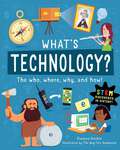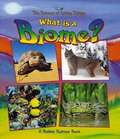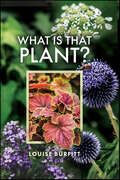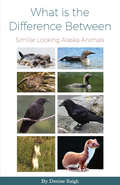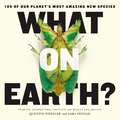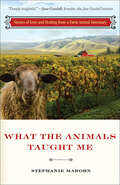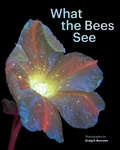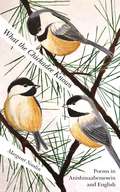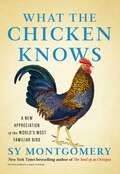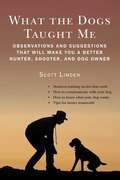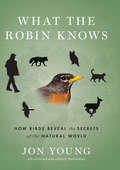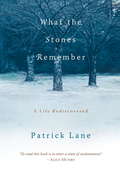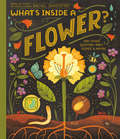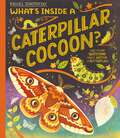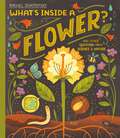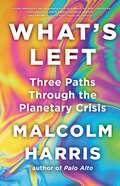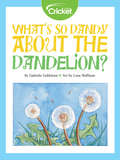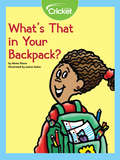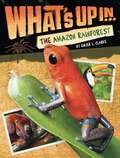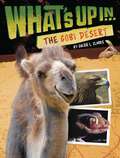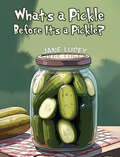- Table View
- List View
What is Technology?: The Who, Where, Why, and How
by Frances DurkinFact-filled non-fiction that uncovers the who where why and how of amazing technological inventions throughout history. From the magic of making music to lightbulb moments and tiny technology the contents focus on the people behind the inventions and the history happening at the time. There is a contents list at the front of the book and a glossary at the back plus a "take it further" activity on each page. Discover the human side of STEM!
What is a Biome? (The Science of Living Things)
by Bobbie KalmanIntroduces biomes, showing and describing the main kinds and discussing their location, climate, and plant and animal life, as well as those developed by humans. Lexile Measure: NC910L
What is that Plant?
by Louise BurfittSpring is the most captivating season of the year for both novice and veteran gardeners as green shoots emerge from bare earth, announcing the promise of beautiful blooms to come. But have you ever found yourself crouched beside a flower bed, puzzling over which plants exactly are pushing their way through the soil? Difficult, but by no means impossible – and this is where this picture-led book, jam-packed with useful information, compelling facts and identification tips for beginners, is at hand. Cataloguing 150 common garden plants found in Britain and Europe, the book covers perennials, flowers, shrubs, weeds and wildflowers as well as a unique section on self-seeding plants, which merrily spread about our gardens and can prove difficult to identify. As well as satisfying your curiosity, identifying the plants in your outdoor space will help you get the most out of your plot. Without knowing which flowers, herbs, shrubs or weeds you are working with, it is impossible to give your garden or allotment the care it needs to thrive. And even those without the luxury of their own outdoor space will find interesting insights on plant names and origins alongside intriguing historical tidbits in this engaging field guide, from the connection between daffodils and dementia in Wales to the controversial history of the hawthorn tree. In this comprehensive directory, you’ll find garden plants organized according to type with hands-on advice for identifying the mystery interlopers in your borders, and information about their height, spread, flowering period and toxicity. Discover a wide array of British garden plants, with practical tips for their care and uses.
What is the Difference Between: Similar Looking Alaska Animals
by Denise SaighWhat is the Difference Between compares Alaska birds and mammals living within the same range and are difficult to tell apart.
What on Earth?: 100 of Our Planet's Most Amazing New Species
by Quentin Wheeler Sara PennakA chameleon so tiny it can fit on your thumbnail? A spider named after David Bowie? A fungus that turns ants into zombies? What on Earth? What on Earth? is a compendium of the 100 coolest, weirdest, and most intriguing new species of this century as determined by the International Institute for Species Exploration. From animals to plants, fossils to bacteria, What on Earth? is an accessible, informative, and offbeat look at the creatures that also call our planet home, including:• A dangerous cobra that can spit its venom almost ten feet • A miniscule orchid that is less than a half-inch wide • A rainforest mushroom named after the cartoon character Spongebob Squarepants • A beautiful seahorse that changes colors to protect itself from predators • A stick insect that is as long as a man&’s arm Featuring visually striking images alongside surprising facts about each new species, What on Earth? is a testament to the incredible and ever-evolving diversity of our planet.
What the Animals Taught Me: Stories of Love and Healing from a Farm Animal Santuary
by Stephanie MarohnIn this “deeply insightful” and “heart warming” memoir, an animal rescuer reveals “profound lessons” learned while living on an animal sanctuary (Jane Goodall).What the Animals Taught Me is a collection of stories about rescued farm animals in a shelter in Sonoma County, California, and what these animals can teach us. Each story illuminates how animals can help us see and embrace others as they truly are and reconnect us with the natural world.Wishing to escape the urban rat race, freelance writer and editor Stephanie Marohn moved to rural northern California in 1993. Life was sweet. She was a busy freelancer. In return for reduced rent, she fed and cared for two horses and a donkey. Her life was full. And then, more farm animals started to appear: a miniature white horse, a donkey, sheep, chickens, followed by deer and other wildlife. Each one needed sanctuary either from abuse, physical injury, or neglect. Marohn took each animal in and gradually turned her ten-acre spread into an animal sanctuary. A deeply inspiring collection, What the Animals Taught Me awakens our hearts and reminds us that our best life teachers sometimes come covered in fur.“One of the best books I have ever read on the way animals open our hearts and teach us unforgettable lessons about life.” —Andrew Harvey, author of The Hope: A Guide to Sacred Activism and The Direct Path
What the Bears Know: How I Found Truth and Magic in America's Most Misunderstood Creatures—A Memoir by Animal Planet's "The Bear Whisperer"
by Chris Erskine Steve SearlesThe incredible story of how one man went from a hired hunter to becoming one of America&’s top champions for this iconic animal.In this wonderous and eye-opening exploration, Steve Searles, the reknown and respected "Bear Whisperer" of Mammoth Lakes, takes the reader on a journey into the lives of these remarkable creatures and the world we share. In the late 1990s, the town of Mammoth Lakes, California hired Steve Searles as a hunter to cull half its troublesome bear population. But as he began to prepare for the grim task, the bears soon won him over, and Searles realized there had to be a better way. He soon developed non-lethal tactics to control their behavior and overpopulation that heralded a landmark moment in the care and handling of the American black bear. But change was not without its challenges. To some, his success was dismissed due to his lack of formal academic training. Yet Searles never wavered in his commitment, and eventually became not just local folk hero but a nationally recognized expert. This high school dropout saved not just the bears, but, in many ways, his community. In a tradition that runs from John Muir to Bear Grylls, Searles finds a fellowship with nature and a deeper meaning in the world of bears. Do bears understand things we don&’t? Are they dialed in to some greater natural force? Unlike us, bears waste little time on unreasonable fears. Bears are fully in the moment. They have an inner peace that seems to offset their power and strength. That may explain why no other animal on the planet is as revered as the bear. As Searles shares his remarkable knowledge and we become immersed in the ursine world, you&’ll never look at bears or nature the same way again. Warm and poignant, and perfect for anyone who has been fascinated by the natural world, What the Bears Know shows that wisdom and fulfillment can come from unexpected places.
What the Bees See
by Craig P. BurrowsDiscover the magical world of the honeybee with this deluxe book, featuring 70 stunning images shot with ultraviolet technology.A comprehensive look into the amazing science of bees, this book collects mesmerizing ultraviolet-induced visible fluorescence (UVIVF) photography of flowers and nature and offers fascinating research that explores every aspect of our relationship with honeybees. Learn about the history of beekeeping, current environmental impacts affecting bees, and the rise of bee products in medical and wellness spaces. As you travel through the world of bees, you'll discover a diverse range of flora showcased in a whole new light through the ultraviolet spectrum, from orchids and anemones to manuka and cactus blossoms. A gorgeous gift for environmentalists and photography fans alike, this in-depth book invites us to reimagine the world from a bee's point of view and better understand its importance to the future of all life on earth.PHENOMENAL NATURE IMAGERY: Craig P. Burrows has been specializing in UVIVF photography for nearly a decade, and this book includes 70 incredible photos taken using this innovative technique. Burrow's luminescent images capture the magic of nature and showcase flowers glowing in otherworldly blues and teals, simulating how bees and other pollinators become attracted to the plants.GET THE BUZZ ABOUT BEES: In addition to the incredible UV photography, this book features engaging illustrations and infographics, archival and historical images, and original interviews with over forty of the world’s leading experts on bees and bee products. Organized into three distinct sections on bee ecosystems, bee products and cultivation, and modern medical and wellness advances tied to bees, this in-depth book illuminates the extraordinary role the honeybee has played throughout history and will answer questions you didn’t even know you had.SUSTAINABILITY GIFT BOOK: This deluxe photobook is a great gift for nature lovers, bee and beekeeping enthusiasts, and anyone who cares about environmental conservation and preservation. Add it to the shelf with books like the National Geographic Photo Ark series by Joel Sartore and DK's The Bee Book.Perfect for:Bee, insect, and bug enthusiastsNature lovers and environmental activistsFlower and nature photography loversPeople interested in learning about bee products used in medicine, wellness, and skincare People interested in UVIVF technology and innovative photography techniquesFans of nature documentaries like David Attenborough’s Life In Color seriesFans of Craig P. Burrows's research and photography
What the Chickadee Knows (Great Lakes Books Series)
by Margaret NoodinMargaret Noodin explains in the preface of her new poetry collection, What the Chickadee Knows (Gijigijigaaneshiinh Gikendaan), "Whether we hear giji-giji-gaane-shii-shii or chick-a-dee-dee-dee depends on how we have been taught to listen. Our world is shaped by the sounds around us and the filter we use to turn thoughts into words. The lines and images here were conceived first in Anishinaabemowin and then in English. They are an attempt to hear and describe the world according to an Anishinaabe paradigm." The book is concerned with nature, history, tradition, and relationships, and these poems illuminate the vital place of the author’s tribe both in the past and within the contemporary world. What the Chickadee Knows is a gesture toward a future that includes Anishinaabemowin and other indigenous languages seeing growth and revitalization. This bilingual collection includes Anishinaabemowin and English, with the poems mirroring one another on facing pages. In the first part, "What We Notice" (E-Maaminonendamang), Noodin introduces a series of seasonal poems that invoke Anishinaabe science and philosophy. The second part, "History" (Gaa Ezhiwebag), offers nuanced contemporary views of Anishinaabe history. The poems build in urgency, from observations of the natural world and human connection to poems centered in powerful grief and remembrance for events spanning from the Sandy Lake Tragedy of 1850, which resulted in the deaths of more than four hundred Ojibwe people, to the Standing Rock water crisis of 2016, which resulted in the prosecution of Native protesters and, ultimately, the completion of the Dakota Access Pipeline on sacred land. The intent of What the Chickadee Knows is to create a record of the contemporary Anishinaabe worldview as it is situated between the traditions of the past and as it contributes to the innovation needed for survival into the future. Readers of poetry with an interest in world languages and indigenous voices will need this book.
What the Chicken Knows: A New Appreciation of the World's Most Familiar Bird
by Sy MontgomeryA charming and eye-opening exploration of the special relationship between humans and chickens from Sy Montgomery, &“one of our finest chroniclers of the natural world&” (The New York Times). For more than two decades, Sy Montgomery—whose The Soul of an Octopus was a National Book Award finalist—has kept a flock of chickens in her backyard. Each chicken has an individual personality (outgoing or shy, loud or quiet, reckless or cautious) and connects with Sy in her own way. In this short, delightful book, Sy takes us inside the flock and reveals all the things that make chickens such remarkable creatures: only hours after leaving the egg, they are able to walk, run, and peck; relationships are important to them and the average chicken can recognize more than one hundred other chickens; they remember the past and anticipate the future; and they communicate specific information through at least twenty-four distinct calls. Visitors to her home are astonished by all this, but for Sy what&’s more astonishing is how little most people know about chickens, especially considering there are about twenty percent more chickens on earth than people. With a winning combination of personal narrative and science, What the Chicken Knows is exactly the kind of book that has made Sy Montgomery such a beloved and popular author.
What the Dogs Taught Me: Observations and Suggestions That Will Make You a Better Hunter, Shooter, and Dog Owner
by Scott Linden“My dogs and I get along best when I hit the birds they produce for me. Putting the odds in my favor is the least I can do. Now, so can you.”If you hunt for pheasants, grouse, quail, and other upland birds, forming a partnership with your dog can be a daunting challenge. Wingshooting USA’s Scott Linden is here to help. What the Dogs Taught Me fills in the blanks for the wingshooter and dog owner with solid advice that will improve dog and hunter’s levels of communication, respect, and hunting efficiency.With lessons on dogs’ desires, skills, and abilities to learn, care and feeding, health and safety, preparation, and shooting, What the Dogs Taught Me is the ultimate guide to maximizing happiness and minimizing frustration whether out on the hunt or relaxing in the backyard. Even better, Linden’s lovable, often hilarious tone makes taking advice on training, strategizing, and partnership enjoyable to human and canine alike.Don’t be a student at the school of hard knocks—What the Dogs Taught Me advances an upland hunter’s skills quickly, creatively, and without any of the angst of more difficult methods.
What the Robin Knows
by Jon YoungCompanion audio files are available at www.hmhbooks.com/whattherobinknows A lifelong birder, tracker, and naturalist, Jon Young is guided in his work and teaching by three basic premises: the robin, junco, and other songbirds know everything important about their environment, be it backyard or forest; by tuning in to their vocalizations and behavior, we can acquire much of this wisdom for our own pleasure and benefit; and the birds' companion calls and warning alarms are just as important as their songs. Birds are the sentries--and our key to understanding the world beyond our front door. Unwitting humans create a zone of disturbance that scatters the wildlife. Respectful humans who heed the birds acquire an awareness that radically changes the dynamic. We are welcome in their habitat. The birds don't fly away. The larger animals don't race off. No longer hapless intruders, we now find, see, and engage the deer, the fox, the red-shouldered hawk--even the elusive, whispering wren. Deep bird language is an ancient discipline, perfected by Native peoples the world over. Finally, science is catching up. This groundbreaking book unites the indigenous knowledge, the latest research, and the author's own experience of four decades in the field to lead us toward a deeper connection to the animals and, in the end, a deeper connection to ourselves.
What the Stones Remember: A Life Rediscovered
by Patrick LaneIn this exquisitely written memoir, poet Patrick Lane describes his raw and tender emergence at age sixty from a lifetime of alcohol and drug addiction. He spent the first year of his sobriety close to home, tending his garden, where he cast his mind back over his life, searching for the memories he'd tried to drown in vodka. Lane has gardened for as long as he can remember, and his garden's life has become inseparable from his own. A new bloom on a plant, a skirmish among the birds, the way a tree bends in the wind, and the slow, measured change of seasons invariably bring to his mind an episode from his eventful past. What the Stones Remember is the emerging chronicle of Lane's attempt to face those memories, as well as his new self--to rediscover his life. In this powerful and beautifully written book, Lane offers readers an unflinching and unsentimental account of coming to one's senses in the presence of nature.
What's Inside A Flower?: And Other Questions About Science & Nature (What's Inside)
by Rachel IgnotofskyFrom the creator of the New York Times bestseller Women in Science, comes a new nonfiction picture book series ready to grow young scientists by nurturing their curiosity about the natural world--starting with what's inside a flower.Budding backyard scientists can start exploring their world with this stunning introduction to these flowery show-stoppers--from seeds to roots to blooms. Learning how flowers grow gives kids beautiful building blocks of science and inquiry.In the launch of a new nonfiction picture book series, Rachel Ignotofsky's distinctive art style and engaging, informative text clearly answers any questions a child (or adult) could have about flowers.
What's Inside a Caterpillar Cocoon?: And other questions about moths and butterflies
by Rachel IgnotofskyButterflies soar in the sunlight while moths flutter under the moon and stars, and both have been around since the dinosaurs roamed the Earth! From pupas inside a chrysalis or cocoons to camouflaging techniques and what butterflies and moths eat, find out more about these mysterious and majestic insects' similarities and differences, and their awe-inspiring metamorphosis!From the creator of the New York Times bestseller Women in Science, Rachel Ignotofsky, What's Inside a Caterpillar Cocoon? is the perfect book for young scientists who want to grow by nurturing their curiosity about the natural world.
What's Inside a Flower?: And other questions about science and nature
by Rachel IgnotofskyFrom pollination and scattering seeds to labelled diagrams of roots, stamens and stems, discover everything there is to know about flowers. Flowers live everywhere, but what are they made of? And how do they grow? Budding backyard scientists can find out with this picture book guide.From the creator of the New York Times bestseller Women in Science, Rachel Ignotofsky, What's Inside a Flower? is the perfect book for young botanists who want to grow by nurturing their curiosity about the natural world.
What's Left: Three Paths Through the Planetary Crisis
by Malcolm HarrisA vital guide for collective political action against the climate apocalypse, from bestselling progressive intellectual Malcolm Harris—&“a brilliant thinker and writer capable of making the intricacies of economic conditions supremely readable&” (Vulture). Climate change is the unifying crisis of our time. But the scale of the problem can be paralyzing, especially when corporations are actively staving off changes that could save the planet but which might threaten their bottom lines. To quote Greta Thunberg, despite very clear science and very real devastation, the adults at the table are still saying &“blah blah blah.&” Something has to change—but what, and how? In What's Left, Malcolm Harris cuts through the noise and gets real about our remaining options for saving the world. Just as humans have caused climate change, we hold the power to avert a climate apocalypse, but that will only happen through collective political action. Harris outlines the three strategies—progressive, socialist, and revolutionary—that have any chance of succeeding, while also revealing that none of them can succeed on their own. What's Left shows how we must combine them into a single pathway: a meta-strategy, one that will ensure we can move forward together rather than squabbling over potential solutions while the world burns. Vital and transformative, What's Left confirms Malcolm Harris as next-generation David Graeber or Mike Davis—a historian-activist who shows us where we stand and how we got here, while also blazing a path toward a brighter future.
What's So Dandy About the Dandelion?
by Gabriele GoldstoneThe name dandelion comes from the French for "tooth of the lion." But are these flowers actually dangerous?
What's So Special about Planet Earth?
by Robert E WellsMove to another planet? Sounds interesting! In our imaginary spaceship, let's check out the planets in our solar system. Mercury is closest, but it has no air, and it's either sizzling hot or bitterly cold. The atmosphere on Venus is poisonous; plus, human beings would cook there. Mars might work, but you'd always have to be in a protective shelter. And if you got to the outer planets, you couldn't even land as they are mostly made of gas! Our home planet is looking good. Why is Earth so comfortable for plants, animals, and people? As Robert E. Wells explains, it's because of our just-right position from the sun, marvelous atmosphere, and abundant water. Our planet is very special and perfect for us, and that's why we must do all we can to keep Earth healthy.
What's That in Your Backpack?
by Mona PeaseAre you carrying a forest on your back? Of course not! But if you dig through your backpack, you will probably find many things that come from the forest.
What's Up in the Amazon Rainforest (What's Up)
by Ginjer L. ClarkeWhere in the world will you find 427 different types of mammals, 1,294 birds, 2,200 fishes, 378 reptiles, 428 amphibians, and about 1 million insects? The Amazon Rainforest, of course! Get lost in the largest rainforest in the world to climb trees that are 500 years old, swim with a pink dolphin, avoid the deadly poison dart frogs, and sleep with a troop of twenty howler monkeys. In What's Up in the Amazon Rainforest, you'll learn all about the plants and animals, as well as the people that live there and the habitat itself.
What's Up in the Gobi Desert (What's Up)
by Ginjer L. ClarkeExplore the Gobi Desert with the second book in this nonfiction geography series, packed with full-color photographs and a fold-out map! Gobi means "waterless place" - the perfect name for a desert! The Gobi covers parts of northern China and southern Mongolia. But contrary to the typical desert image, only 5% of the Gobi has sand dunes! It is also very cold, with an average temperature of only 37 degrees Fahrenheit for the entire year. Explore the expanse of the Gobi Desert with this fascinating addition to the What's Up series, and discover the wild plants, animals, and people that call this habitat home.
What's Up?: Watching the Night Sky (Into Reading, Level N #56)
by Olivia SnowNIMAC-sourced textbook <p><p> Have you ever gone outside to look at the night sky? This book can help you learn what to look for.
What's a Pickle Before It's a Pickle?
by Jane LuceyChildren are so curious about the world around them. They come up with so many exciting questions. What&’s a Pickle Before It&’s a Pickle? invites children to use prior knowledge and guess how some very familiar things come to be. Just what was that pickle before we buy them in a jar? When they turn the page, they can be surprised, or maybe be excited that they knew the answer. It is written in rhyme to make it fun and energetic, providing an opening for the children to read along by catching on to some of the rhyming words, perhaps even finishing some of the sentences!
What's in Your Pocket?: Collecting Nature's Treasures
by Heather L. MontgomeryCharles Darwin, George Washington Carver, and Jane Goodall were once curious kids with pockets full of treasures!When you find something strange and wonderful, do you put it in your pocket? Meet nine scientists who, as kids, explored the great outdoors and collected "treasures": seedpods, fossils, worms, and more. Observing, sorting, and classifying their finds taught these kids scientific skills--and sometimes led to groundbreaking discoveries. Author Heather Montgomery has all the science flair of a new Bill Nye. Book includes the Heather's tips for responsible collecting.
